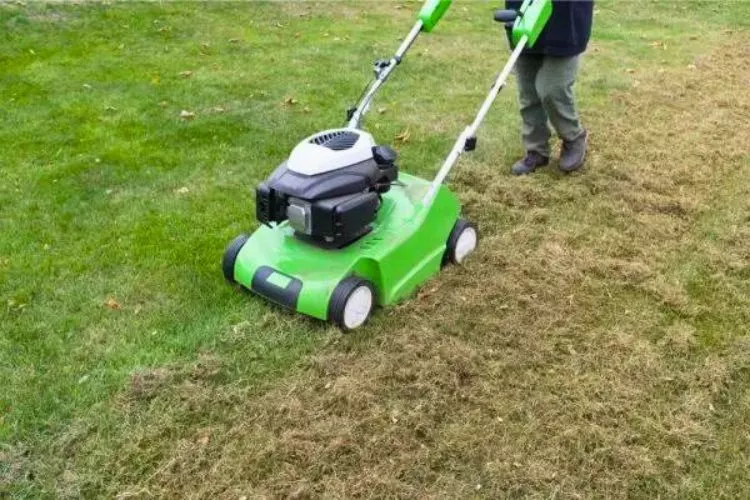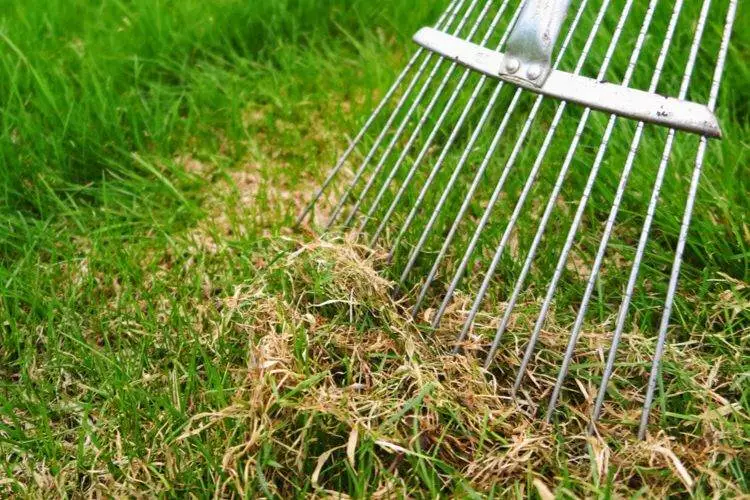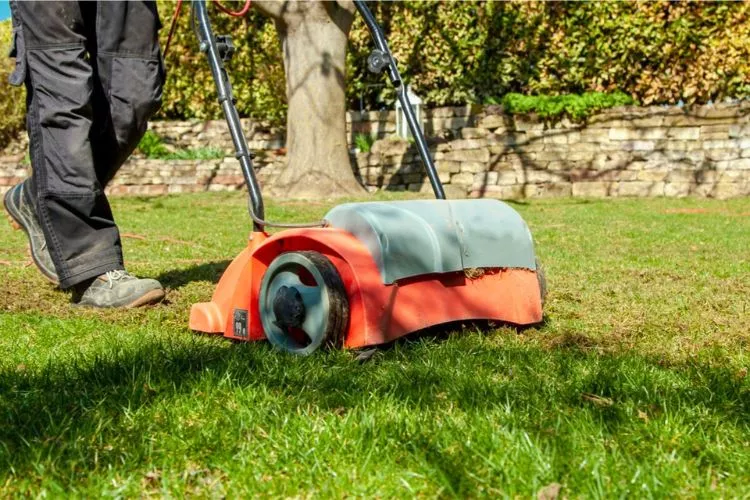Dethatching removes a layer of dead grass, leaves, and other debris accumulating on a lawn over time.
This buildup, known as “thatch,” can prevent water and nutrients from reaching the soil. As a result, you will cultivate an unhealthy and unsightly lawn.
But, can you dethatch a wet lawn?
Honestly speaking, dethatching a wet lawn can be risky and may lead to further damage if not done correctly. Dethatching is necessary for curating and maintaining a healthy lawn, but it should be done under the right conditions. Ideally, the lawn should be dry, and the soil should be moist but not saturated.
In this article, we’ll go through the dos and don’ts surrounding detaching in certain conditions, including when wet.

Table of Contents
Can you dethatch a wet lawn? (The Truth)
Dethatching is an essential part of lawn maintenance, but the answer is not as straightforward when it comes to dethatching a wet lawn. While it is technically possible to dethatch a wet lawn, doing so can pose several risks and complications that can damage your lawn and make the thatch problem even worse.
Risks of dethatching a wet lawn
Dethatching in the wet can be problematic for a few reasons. The biggest issue is accessing the grass and soil underneath without damaging the wet grass above. Let’s have a look at the risks that dethatching a wet lawn can pose in detail:

- Soil Compaction: Dethatching a wet lawn can result in soil compaction, as the equipment used to dethatch can pack the moist soil much more tightly. This can make it difficult for roots to access and absorb water and nutrients. As a result, the grass can become damaged and won’t grow. Additionally, compacted soil can cause water to pool, which can cause further damage to the grassroots.
- Grass Damage: Dethatching equipment is designed to dig into the soil and remove the thatch layer. When the soil is wet, the grass is more vulnerable to being pulled up or torn out by this equipment. Furthermore, wet grass is also more susceptible to damage from heavy equipment, such as a dethatching machine. This can leave unsightly bare patches on the lawn and create favorable conditions for weed growth.
- Disease Spread: Wet conditions promote the growth of fungi and other pathogens that can cause serious damage to the grass. So, when a wet lawn is dethatched, the equipment has the potential to spread fungal spores and other pathogens throughout the lawn, which can further damage the grass.
- Increased Thatch Buildup: Dethatching a wet lawn can cause the thatch layer to clump together, making removing it more difficult. This can result in further thatch buildup, which makes it even harder for water and nutrients to reach the soil. This can also lead to poor air circulation around the roots, which can cause the grass to weaken.
In summary, dethatching a wet lawn can pose several risks that can harm the grass and worsen the thatch problem.
To minimize these risks, it is best to wait until the lawn is dry and the soil is slightly moist but not saturated before attempting to dethatch.
When should you not dethatch your lawn?
While dethatching is an important part of lawn maintenance, there are times when it is not recommended. Here are a few instances when you should avoid dethatching your lawn:
- During Extreme Weather Conditions: It is not recommended to dethatch your lawn during extreme weather conditions, such as when it is too hot, too cold, or too dry. Dethatching during extreme weather conditions can stress your lawn more and cause more harm than good. The heat will dry out the soil and leave it lifeless. The cold can freeze the thatch and grass underneath, so when it is removed, it can rip everything up at once.
- After Overseeding: If you have recently overseeded your lawn, it is best to avoid dethatching for at least 3-4 weeks. Dethatching can damage the new seedlings and make it harder for them to establish themselves.
- If Your Lawn Is Already Stressed: If your lawn is already struggling with other issues, such as disease or insect infestations, dethatching can further stress the grass and make it more vulnerable to damage. It is best to address any existing issues before attempting to dethatch.
- If The Thatch Layer Is Thin: If your lawn has a thin layer of thatch, dethatching may not even be necessary. Removing too much thatch can damage the roots and cause more harm than good.
What is the best time to dethatch your lawn?
The best time to dethatch your lawn is during the growing season, typically in the spring or fall.
During these seasons, the grass is actively growing and has a greater chance of recovering from the stress of the dethatching process.
Additionally, these seasons typically have moderate temperatures and rainfall, providing optimal conditions for the grass to recover.
There is no one best time of day to dethatch a lawn, but there are a few things to consider when choosing when to dethatch.
One factor to consider is the temperature. It is best to dethatch when the temperature is mild, typically in the early morning or late afternoon.
Dethatching in the middle of the day, when temperatures are at their highest, can put additional stress on the grass and increase the risk of damage.

You should also consider the amount of sun exposure. If your lawn is in direct sunlight for most of the day, it may be best to dethatch in the early morning or late afternoon when the sun is not as intense.
This can reduce the risk of damage to the grass and prevent the soil from drying out too quickly.
Another factor to consider is the type of grass you have. Cool-season grasses like fescue and bluegrass should be dethatched in the early spring or fall.
Warm-season grasses like Bermuda and zoysia should be dethatched in the late spring or early summer.
Ultimately, it’s important to dethatch your lawn when necessary rather than on a set schedule. The frequency of dethatching depends on how quickly thatch builds up on your lawn.
It is generally recommended to dethatch once a year or every other year, depending on the severity of thatch buildup.
Factors to consider before dethatching a lawn
Dethatching can be a necessary part of lawn maintenance, but it is important to consider several factors before attempting so. Here are some important factors to consider before dethatching a lawn:

Type of grass
Different types of grass require different dethatching methods. For example, cool-season grasses like fescue and bluegrass can be dethatched more aggressively than warm-season grasses, such as Bermuda and zoysia.
Researching the appropriate dethatching method for your grass type is important to avoid damaging the turf. You may even require different tools depending on the varying heights and thicknesses of the thatched grass.
Soil conditions
It is best to dethatch when the soil is slightly moist but not saturated. Dethatching in dry conditions can make it difficult to remove the thatch layer.
Dethatching in wet conditions can increase the risk of soil compaction, grass damage, disease spread, and thatch buildup.
If you’re unsure how your soul will react to this process, it’s a good idea to take a soil sample. This will help you decide what tactic to use.
Weather forecast
It is important to check the weather forecast before dethatching to ensure that there will be adequate time for the grass to recover from any inclement weather.
Ideally, dethatching should be done when there is a stretch of moderate temperatures and rainfall. This will save any problems while digging and correcting the thatching.
Age of the lawn
Older lawns may require more aggressive dethatching to remove a thicker layer of thatch. However, aggressive dethatching can damage the roots and harm the lawn.
You may feel that you are simply pulling up the top layer but take some of the undersides with the top layer. It is important to assess the age of the lawn and the severity of thatch buildup to determine the appropriate dethatching method.
The severity of thatch buildup
It is important to assess the severity of thatch buildup before attempting to dethatch. If the thatch layer is too thin, dethatching may not be necessary.
If the thatch layer is too thick, more aggressive dethatching may be required. It is important to find the appropriate balance to avoid damaging the grass. You should only really dethatch when necessary.
Frequently Asked Questions (fAQs)
Should I dethatch before or after rain?
It is best to dethatch when the soil is slightly moist but not saturated. It is not recommended to dethatch before or after heavy rainfall.
Should I water after dethatching?
Watering your lawn after dethatching is recommended to help the grass recover and promote new growth. Watering will also help to wash away any debris left behind by the dethatching process. However, avoid drenching as it can dislodge the roots. Shorter, sharper bursts are recommended straight after the dethatching works are complete
Conclusion
Dethatching is important for maintaining a healthy lawn. However, it’s important to time it right and do so under the right conditions.
Dethatching a wet lawn can pose several risks, including soil compaction, grass damage, disease spread, etc.
By considering factors such as grass type, soil conditions, weather forecast, age of the lawn, etc., you can determine the appropriate dethatching method and timing.
We hope this guide has helped provide information about this process. Remember to always assess the condition of your lawn and dethatch only when necessary.
You can read about similar topics here on our website. Check back again soon for more.


